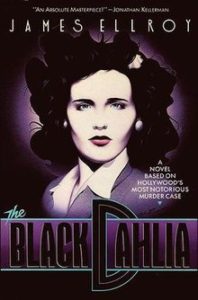

She will come to be known as the Black Dahlia, a young woman named Elizabeth Short, and her murderer will never be found. We can easily read the secrets she will never tell: days of unspeakable torture, and, in her portrait photos, of dreams deformed into horror. Her knees are broken and a triangle of flesh is missing from her left thigh. Her second half begins above her pubic bone, her legs spread in a necrophiliac's wet dream pose, an open gash like an arrow pointing towards her vagina. Beneath the rib cage, nothing she is disassembled. Cigarette burns stubble her breasts, one of which is still attached by only a gristle of meat. Her face bears a split-open camprachico smile, battered sunken eyes, a pulped nose. The woman is severed, the two halves of her pale, bloodless body placed as carefully in a Los Angeles lot as one would hang a painting in an art gallery. The following is a review I wrote of the book nearly 10 years ago for some long-gone website or another, and I think it's wholly appropriate for Too Much Horror Fiction. And it turned out to be one of the most horrifying novels I'd ever read. I had to read the book it was that simple. Then when I saw the artist's ( Stephen Peringer) rendering of Short on the cover of the Mysterious Press paperback of The Black Dahlia awhile later, I was struck by its similarity to Fenn.

In those days I was, like many young men, pretty much obsessed with Sherilyn Fenn and her character Audrey Horne on David Lynch's 1990/91 TV show, "Twin Peaks." Her noir-tastic photo from the previous summer's Rolling Stone magazine was one I couldn't shake.

Why did I choose to read it? I'd never read a crime novel before. I read The Black Dahlia for the first time in early 1991. But The Black Dahlia thrives in both arenas. Horror, to paraphrase Poe and Lovecraft, is about that singular frisson of terror itself. But because it's concerned with the procedural aspects of tracking down criminals, and not solely trying to freak you out, it gets a pass on the horror label.

The genres seem to split fans too: how many people deny The Silence of the Lambs is horror? And yet it's about a serial killer and a cannibal. The two genres delve into human depravity but approach it in different manners: crime is generally matter-of-fact in its dealings with violence horror wants to reduce you to whimpers and overwhelm you. I've been thinking about Ellroy since he's got this new TV series starting up on the history of Los Angeles murders and scandals, as well as my recent musings about the intersection of crime and horror fiction. My introduction to the disturbing real-life horror story that is the death of Elizabeth Short came in the form of James Ellroy's novel The Black Dahlia.


 0 kommentar(er)
0 kommentar(er)
